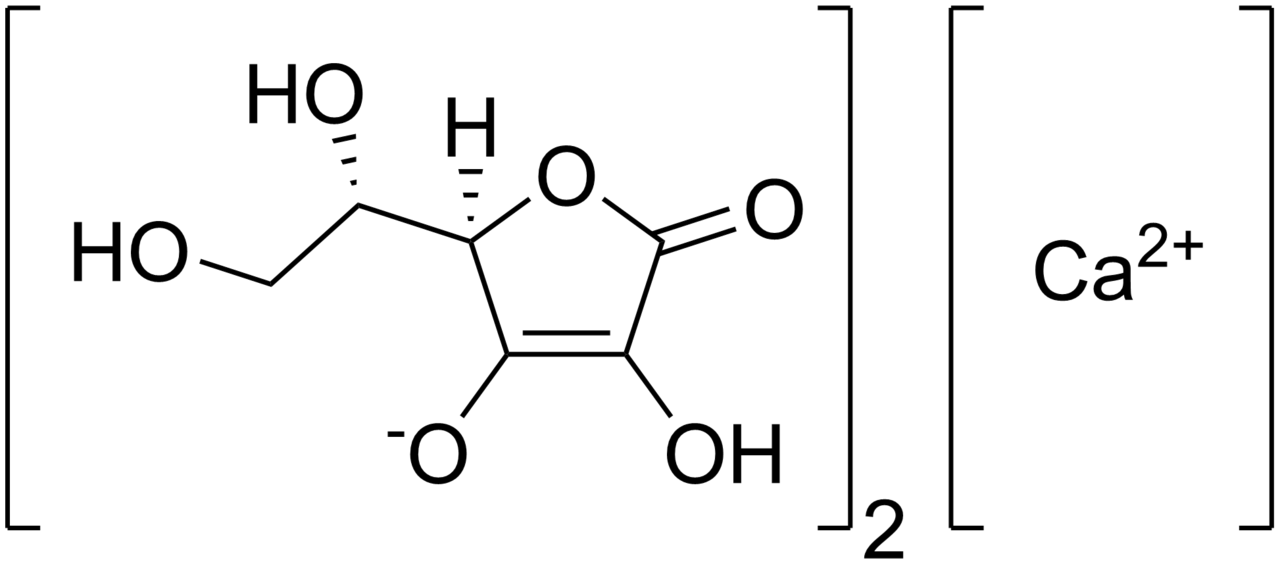Difference Between Ester C And Regular Vitamin C
Main Difference – Vitamin C vs Ester C
There seems to be a lot of confusion over the difference between vitamin C and Ester C. Vitamin C is a water-soluble essential vitamin and represents a group of nutritional organic composites that comprises of L-ascorbic acid, ascorbate, and dehydro-ascorbic acid. Vitamin C is particularly significant for the health of the skin and immune system, and collagen synthesis. In contrast, ester C is calcium ascorbate which is synthesized by buffering L-ascorbic acid with calcium. Vitamin C (L-ascorbic acid) has an acidic pH, and ester C has a neutral pH. Most importantly, vitamin C has low bioavailability compared to ester C. This is the main difference between vitamin C and Ester C. In this article, let's elaborate the difference between vitamin C and Ester C in terms of their intended uses and other chemical characteristics.
What is Vitamin C
Vitamin C is essential for overall health of human being. It is chemically known as L-ascorbic acid which is a weaker organic acid. Vitamin C represents L-ascorbic acid, ascorbate (salt of ascorbic acid) and dehydro-ascorbic acid (oxidized ascorbic acid). These three types of molecules have vitamin C biological activity. L-ascorbic acid can exist mainly at acidic pH or low pH. In the biological system, vitamin C acts as a cofactor in various enzymatic reactions and is also involved in the collagen, norepinephrine, and carnitine synthesis. In addition, ascorbate may act as a natural antioxidant against oxidative stress. The deficiency of vitamin C can cause the scurvy. Vitamin C is poorly absorbed by the mammalian intestinal tract and cannot be produced to reimburse for the deficiency. Recommended Dietary Allowance of vitamin C is 90 mg per day for an adult male and 75 mg per day for an adult female.
What is Ester C
Ester-C is an innovative patented form of vitamin C supplement formula, and chemically it is known as Calcium Ascorbate. The industrial production process involves buffering of L-ascorbic acid with a calcium salt. This form of vitamin C is having higher bioavailability because it is also combined with naturally-occurring vitamin C metabolites. As a result, the human gut can efficiently assimilate a higher percentage of ester C when compared to natural ascorbic acid. Ester C is a non-acidic product, and its pH is equal to 7. Biologically, both vitamin C and ester C are involved in the same functions. The production of ester C may include heating up the ascorbic acid which leads to the production of dehydro-ascorbate (DHA). DHA is a strong antiviral compound, and it can enter into the mitochondrial membrane which can protect from mitochondrial dysfunctions. DHA can also enter through the GLUT transporters and transform into ascorbate in the brain for normal functioning as well as to protect the neuronal tissue from ischemic stroke.

Difference Between Vitamin C and Ester C
The differences between vitamin C and Ester C can be divided into following categories. They are;
Chemical Name and Formula
Vitamin C is a water-soluble sugar acid and structurally allied to glucose. Its IUPAC name is 2-oxo-L-threo-hexono-1,4-lactone-2,3-enediol. Its chemical formula is C6H8O6.
Ester Ccontains Calcium ascorbate as its the main chemical ingredient. Its IUPAC name is calcium (2R)-2-[(1S)-1,2-dihydroxyethyl]-4-hydroxy-5-oxo-2H-furan-3-olate. Its chemical formula is CaC12H14O12. It also contains vitamin C metabolites.
Chemical Composition
Vitamin C only contains L-ascorbic acid.
Ester C is a combination of calcium ascorbate, Dehydroascorbate, calcium threonate, lyxonate, and xylonate.

Bioavailability
Vitamin C has less bioavailability compared to ester C.
Ester C has three or four times greater bioavailability than regular natural vitamin C. But this fact is highly controversial.
Acidity
Vitamin C is an acidic compound.
Ester C is a pH neutral product.
Source
Vitamin C is naturally derived from fresh fruits and vegetables. It is rich in guava, nelli, mangoes, tomato, red pepper, broccoli, grape, apricot, asparagus, pumpkin, papayas, carrots, yams, green leafy vegetables and edible green leaves such as spinach, kale, sweet potato leaves, and sweet gourd leaves.
Ester C is not a natural product. It is a synthetic product. It is available in liquid, chewable and powder form.
Economic Significance
Vitamin C is less expensive than ester C.
Ester C is more expensive than vitamin C.
Side Effects
Excessive Vitamin C consumption can cause gastrointestinal abnormalities, diarrhea, and formation of kidney stones, reduced Vitamin B12 absorption, excess iron absorption and cellular damage for some individuals.
Use of Ester C in chemotherapy patients/ with chemotherapy is controversial.
Food Additive
Vitamin C is widely used as a food additive, to prevent oxidation and to enhance shelf-life.
Ester C is not used as a food additive.
In conclusion, vitamin C is an essential nutrient to the human body. Ester C is a vital vitamin supplement which is important to increase the vitamin C content in the human body. Both Vitamin C and ester C are involved in the similar biological functions without many significant differences. Both Vitamin C and ester C has proved to be effective against cancers, LDLs in atherosclerotic lesions and other cardiovascular diseases. However, vitamin C is a natural and safe supplement. But, ester C can be used in severe cases of scurvy as well as patients with gastrointestinal problems.
References:
Fay, M.J. et al. (1991). Stimulatory action of calcium L-threonate on ascorbic acid uptake by a human T-lymphoma cell line. Life Science. 49: 1377-81.
Gruenwald, J. et al. (2006). Safety and tolerance of Ester-C compared with regular ascorbic acid. Advances in Therapy. 23(1): Jan-Feb: 171-8.
Higdon J (2006). Vitamin C. Oregon State University, Micronutrient Information Center. Retrieved March 7, 2007.
Image Courtesy:
"Lemon and Lime" by John Robinson (CC BY 2.0) via Flickr
"VitaminSupplementPills2" by Raysonho @ Open Grid Scheduler / Grid Engine – Own work. (CC0) via Commons
"L-Ascorbic acid" by Yikrazuul – Own work. Licensed under (Public Domain) via Wikimedia Commons
"Calcium ascorbate" by Edgar181 (talk) – Own work. (Public Domain) via Wikimedia Commons

Difference Between Ester C And Regular Vitamin C
Source: https://pediaa.com/difference-between-vitamin-c-and-ester-c/
